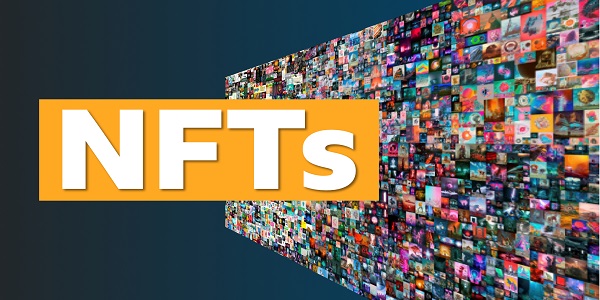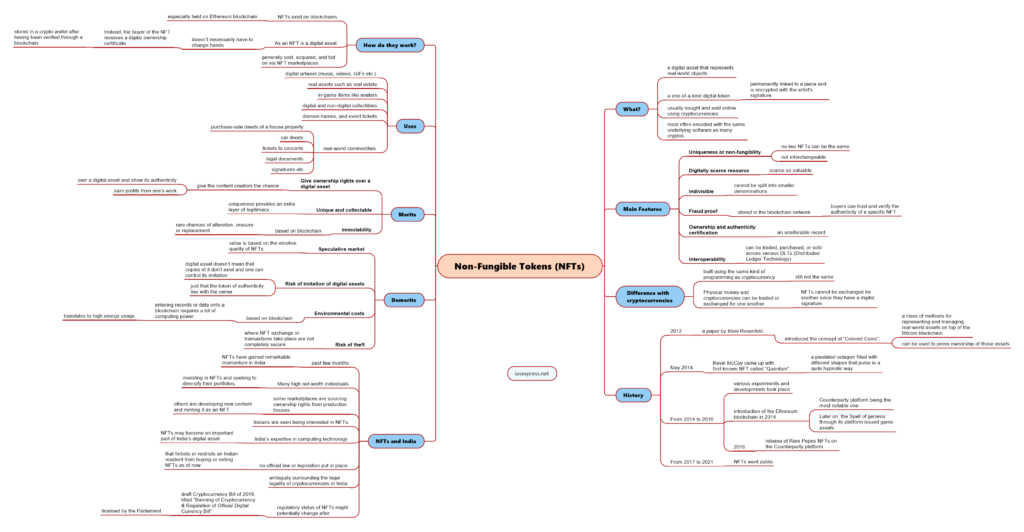Non-Fungible Tokens (NFTs) – Merits, Demerits and Scope in India

From Current Affairs Notes for UPSC » Editorials & In-depths » This topic
IAS EXPRESS Vs UPSC Prelims 2024: 85+ questions reflected
In the era of digital technology touching new heights, various technological innovations have come as a breakthrough. One such feat achieved in technological innovation is the advent of non-fungible tokens (NFTs). NFTs have become the subject of discussion since they have come as a saviour in a time of piracy and online fraud. They not only offer authenticity to various digital creations but also allow the owner to own such digital assets that can be replicated endlessly. Thus, it is important to know what are NFTs, how do they work and many other aspects related to them.

What are non-fungible tokens (NFTs)?
- An NFT is a digital asset that represents real-world objects like art, music, in-game items and videos.
- In other words, it is a one-of-a-kind digital token that is permanently linked to a piece and is encrypted with the artist’s signature.
- They are usually bought and sold online using cryptocurrencies and are most often encoded with the same underlying software as many cryptos.
Main features
- Uniqueness or non-fungibility
- NFTs are unique and no two NFTs can be the same. Two NFTs are not interchangeable. They cannot be replaced with something else. Each NFT’s unique property is usually stored in tokens metadata.
- Digitally scarce resource
- They are scarce and that is the reason that they are so valuable.
- Indivisible
- Most of the NFTs cannot be split into smaller denominations; which means one cannot buy or transfer a fraction of NFTs.
- Fraud proof
- As they are stored in the blockchain network, they are fraud-proof.
- As public distributed ledgers are decentralized and immutable, where records of token issuance, transfer, and activity can be publicly verified, buyers can trust and verify the authenticity of a specific NFT.
- Ownership and authenticity certification
- The metadata of each NFT is an unalterable record that gives it the certificate of authenticity.
- The original creators of the NFTs control the private key of that account where the NFT lives, and they’re free to transfer that NFT to any account.
- Interoperability
- NFTs can be traded, purchased, or sold across various DLTs (Distributed Ledger Technology) using a decentralized bridge or centralized custodial service.
How is it different from cryptocurrency?
- Although NFTs are built using the same kind of programming as cryptocurrency, they are not the same.
- Physical money and cryptocurrencies are “fungible,” meaning they can be traded or exchanged for one another while NFTs cannot be exchanged for another since they have a digital signature that makes it impossible for them to be exchanged for or equal to one another, thus ‘non-fungible’.
History of NFTs
- The story begins with the release of a paper by Meni Rosenfeld in 2012, that introduced the concept of “Colored Coins”, issued on the Bitcoin blockchain.
- Colored Coins describe a class of methods for representing and managing real-world assets on top of the Bitcoin blockchain and can be used to prove ownership of those assets. They are regular Bitcoins, but with a mark on them, that determines their use.
- However, the concept of Colored Coins was never realized due to the limitations of Bitcoin though it laid the groundwork for the development and experimentation of NFTs in future.
- In May 2014, Kevin McCoy came up with first-known NFT called “Quantum”.
- He created his non-fungible token “Quantum,” way before the crypto art market exploded.
- It is a pixelated octagon filled with different shapes that pulse in a quite hypnotic way.
- From 2014 to 2016, various experiments and developments took place in blockchain technology. With the introduction of the Ethereum blockchain in 2014, the new age of NFTs began.
- Counterparty platform being the most notable one that allowed the creation of digital assets.
- Later on, the Spell of genesis through its platform issued game assets.
- Finally, the meme age began in 2016, with the release of Rare Pepes NFTs on the Counterparty platform.
- From 2017 to 2021, NFTs went public. The interest in NFTs showed a drastic rise. Many other blockchains started getting into the game with their version of NFTs, establishing new standards. The demand for NFTs has also seen a remarkable change making the mainstream media predict that there is going to be an NFT explosion.
- Thus, NFTs have become an important element of the latest blockchain technology.
How do NFTs work?
- NFTs exist on blockchains, especially held on Ethereum blockchain. They can also be held on other blockchains.
- As an NFT is a digital asset, the physical item being traded, if there is one, doesn’t necessarily have to change hands. Instead, the buyer of the NFT receives a digital ownership certificate, which is stored in a crypto wallet after having been verified through a blockchain.
- In simple words, NFTs are like physical collector’s items, only digital. So instead of getting an actual oil painting to hang on the wall, the buyer gets a digital file instead. The buyer gets exclusive ownership rights and NFTs can have only one owner at a time.
- NFTs are generally sold, acquired, and bid on via NFT marketplaces, such as OpenSea, Variable, Foundation, and Nifty Gateway.
What are the uses of NFTs?
- Non-fungible tokens can digitally represent any asset, including online-only assets like digital artwork (music, videos, GIFs etc.) and real assets such as real estate.
- They can be used in-game items like avatars, digital and non-digital collectibles, domain names, and event tickets.
- They can also represent real-world commodities like purchase-sale deeds of a house property, car deeds, tickets to concerts, legal documents, signatures etc.
Merits
- Give ownership rights over a digital asset
- They give the content creators the chance to not only own a digital asset and show its authenticity but also to earn profits from one’s work.
- Unique and collectable
- As NFTs are unique and rare, there is an urge among people to collect them.
- Furthermore, their uniqueness provides an extra layer of legitimacy to collectable content especially in the form of digital assets.
- Immutability
- As non-fungible tokens (NFTs) are based on blockchain, there are rare chances of alteration, erasure or replacement.
- One of the reasons why they are valuable is because they also help in proving the origin or authenticity of digital content.
Demerits
- Speculative market
- The true value of NFTs is yet to be realised. This is because currently, the only value is based on the emotive quality of NFTs.
- Risk of imitation of digital assets
- There is a risk of imitation since the NFT of a digital asset doesn’t mean that copies of it don’t exist and one can control its imitation.
- Art, GIFs and videos posted on various websites may be imitated several times. It is just that the token of authenticity lies with the owner.
- Environmental costs
- It is a well-known fact that NFTs are based on blockchain and entering records or data onto a blockchain requires a lot of computing power which translates to high energy usage. Thus, it is difficult to conclude whether assets such as NFTs based on blockchain are sustainable or not.
- Risk of theft
- Although the technology behind NFTs is secure as compared to other ones, the trading platforms and exchanges where NFT exchange or transactions take place are not completely secure.
- There have been several reports of NFT theft taking place due to cyber security breaches.
NFTs and India
- In the past few months, NFTs have gained remarkable momentum in India among some high net-worth individuals.
- Many high net-worth individuals are investing in NFTs and seeking to diversify their portfolios. Thus, non-fungible tokens (NFTs) are slowly gaining asset-class credibility.
- While some marketplaces are sourcing ownership rights from production houses, others are developing new content and minting it as an NFT. A large number of Indians are seen being interested in NFTs.
- According to NASSCOM, the Indian public sector has supported and driven blockchain-based projects involving more than half of the country’s states.
- Blockchain applications are being identified by businesses across a wide range of industries. Although only 8% of these are in production, the majority are expected to expand this year.
- Given India’s expertise in computing technology and the notion that the crypto market is the soul of technological transformation, NFTs may become an important part of India’s digital asset owned by its population.
- However, there is no official law or legislation put in place by the Indian Government that forbids or restricts an Indian resident from buying or selling NFTs as of now.
- The ambiguity surrounding the legal legality of cryptocurrencies in India appears to be the main roadblock in NFT trading.
- The regulatory status of NFTs might potentially change after the draft Cryptocurrency Bill of 2019, titled “Banning of Cryptocurrency & Regulation of Official Digital Currency Bill” is finalised by the Parliament.
- The easy trading of NFTs in India requires the legalisation of cryptocurrencies. Trading NFTs is risky unless and until a definitive decision on the legality of cryptocurrencies in India is reached.
- Apart from that, there are concerns regarding money laundering, intellectual property infringement, taxation and the influence of NFTs on the environment.
- Thus, India needs to have a well-thought strategy to deal with NFTs.
Conclusion
Although the NFT space is young, numerous opportunities are there that need to be explored. The advent and growing popularity of NFTs are being considered to be mere hype by some. However, with digital technology growing rapidly and the introduction of newer forms, NFTs may stand out to be a real success in the asset class. They can prove to be the future of digital transactions.
Practise Question
Q. What is the scope of non-fungible tokens (NFTs) in India?
If you like this post, please share your feedback in the comments section below so that we will upload more posts like this.

